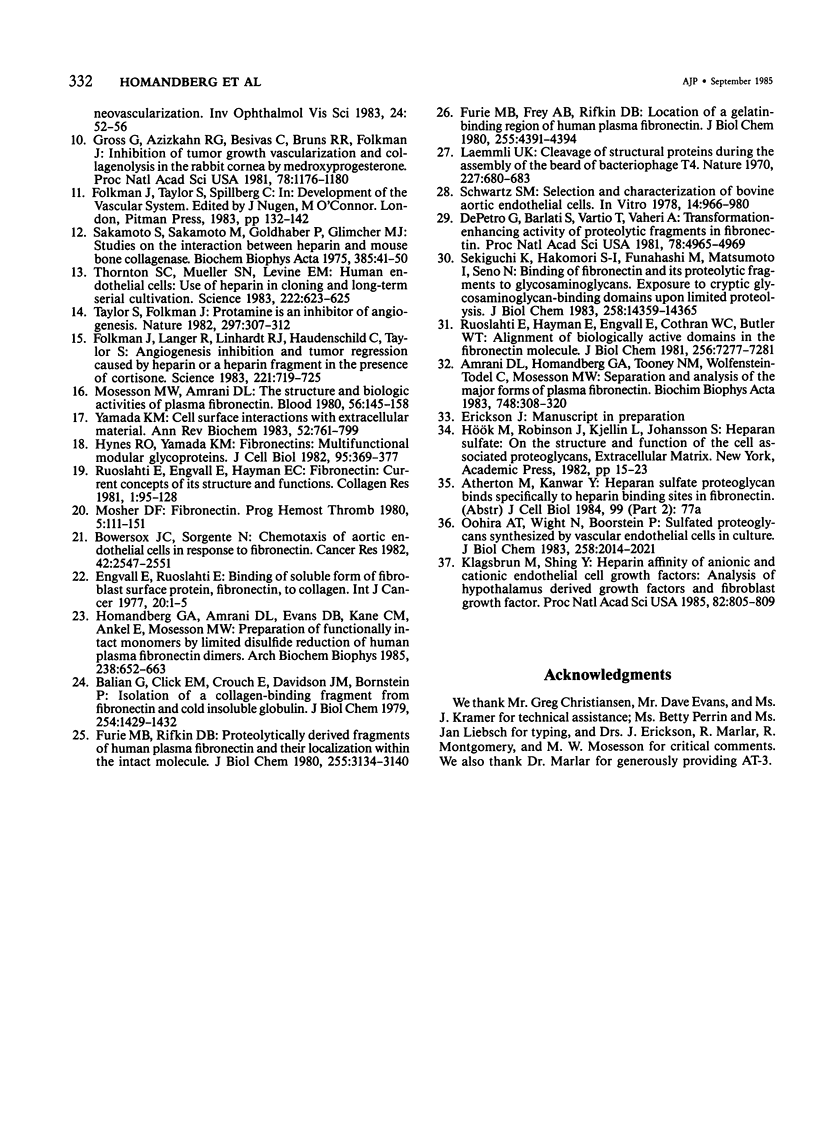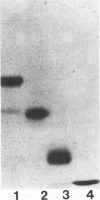Abstract
Two heparin-binding proteolytic fragments of fibronectin--an amino-terminal 29-kd segment and a carboxyl-terminal 40-kd segment-are apparently specific, potent inhibitors of the growth of cultured bovine aortic endothelial cells and inhibit growth in a reversible, dose-dependent manner. In contrast, native fibronectin at higher dosages neither inhibits nor interferes with the effects of the 29-kd fragment. The data, therefore, suggest that fibronectin fragments may participate in the regulation of vascular growth.
Full text
PDF





Images in this article
Selected References
These references are in PubMed. This may not be the complete list of references from this article.
- Amrani D. L., Homandberg G. A., Tooney N. M., Wolfenstein-Todel C., Mosesson M. W. Separation and analysis of the major forms of plasma fibronectin. Biochim Biophys Acta. 1983 Oct 28;748(2):308–320. doi: 10.1016/0167-4838(83)90308-4. [DOI] [PubMed] [Google Scholar]
- Balian G., Click E. M., Crouch E., Davidson J. M., Bornstein P. Isolation of a collagen-binding fragment from fibronectin and cold-insoluble globulin. J Biol Chem. 1979 Mar 10;254(5):1429–1432. [PubMed] [Google Scholar]
- Bowersox J. C., Sorgente N. Chemotaxis of aortic endothelial cells in response to fibronectin. Cancer Res. 1982 Jul;42(7):2547–2551. [PubMed] [Google Scholar]
- De Petro G., Barlati S., Vartio T., Vaheri A. Transformation-enhancing activity of gelatin-binding fragments of fibronectin. Proc Natl Acad Sci U S A. 1981 Aug;78(8):4965–4969. doi: 10.1073/pnas.78.8.4965. [DOI] [PMC free article] [PubMed] [Google Scholar]
- Eisenstein R., Harper E., Kuettner K. E., Schumacher B., Matijevitch B. Growth regulators in connective tissues. II. Evidence for the presence of several growth inhibitors in aortic extracts. Paroi Arterielle. 1979 Oct;5(3):163–169. [PubMed] [Google Scholar]
- Eisenstein R., Kuettner K. E., Neapolitan C., Soble L. W., Sorgente N. The resistance of certain tissues to invasion. III. Cartilage extracts inhibit the growth of fibroblasts and endothelial cells in culture. Am J Pathol. 1975 Nov;81(2):337–348. [PMC free article] [PubMed] [Google Scholar]
- Eisenstein R., Sorgente N., Soble L. W., Miller A., Kuettner K. E. The resistance of certain tissues to invasion: penetrability of explanted tissues by vascularized mesenchyme. Am J Pathol. 1973 Dec;73(3):765–774. [PMC free article] [PubMed] [Google Scholar]
- Engvall E., Ruoslahti E. Binding of soluble form of fibroblast surface protein, fibronectin, to collagen. Int J Cancer. 1977 Jul 15;20(1):1–5. doi: 10.1002/ijc.2910200102. [DOI] [PubMed] [Google Scholar]
- Folkman J., Langer R., Linhardt R. J., Haudenschild C., Taylor S. Angiogenesis inhibition and tumor regression caused by heparin or a heparin fragment in the presence of cortisone. Science. 1983 Aug 19;221(4612):719–725. doi: 10.1126/science.6192498. [DOI] [PubMed] [Google Scholar]
- Furie M. B., Frey A. B., Rifkin D. B. Location of a gelatin-binding region of human plasma fibronectin. J Biol Chem. 1980 May 25;255(10):4391–4394. [PubMed] [Google Scholar]
- Furie M. B., Rifkin D. B. Proteolytically derived fragments of human plasma fibronectin and their localization within the intact molecule. J Biol Chem. 1980 Apr 10;255(7):3134–3140. [PubMed] [Google Scholar]
- Gospodarowicz D., Moran J., Braun D., Birdwell C. Clonal growth of bovine vascular endothelial cells: fibroblast growth factor as a survival agent. Proc Natl Acad Sci U S A. 1976 Nov;73(11):4120–4124. doi: 10.1073/pnas.73.11.4120. [DOI] [PMC free article] [PubMed] [Google Scholar]
- Gross J., Azizkhan R. G., Biswas C., Bruns R. R., Hsieh D. S., Folkman J. Inhibition of tumor growth, vascularization, and collagenolysis in the rabbit cornea by medroxyprogesterone. Proc Natl Acad Sci U S A. 1981 Feb;78(2):1176–1180. doi: 10.1073/pnas.78.2.1176. [DOI] [PMC free article] [PubMed] [Google Scholar]
- Hayman E. G., Pierschbacher M. D., Ruoslahti E. Detachment of cells from culture substrate by soluble fibronectin peptides. J Cell Biol. 1985 Jun;100(6):1948–1954. doi: 10.1083/jcb.100.6.1948. [DOI] [PMC free article] [PubMed] [Google Scholar]
- Homandberg G. A., Amrani D. L., Evans D. B., Kane C. M., Ankel E., Mosesson M. W. Preparation of functionally intact monomers by limited disulfide reduction of human plasma fibronectin dimers. Arch Biochem Biophys. 1985 May 1;238(2):652–663. doi: 10.1016/0003-9861(85)90211-5. [DOI] [PubMed] [Google Scholar]
- Hynes R. O., Yamada K. M. Fibronectins: multifunctional modular glycoproteins. J Cell Biol. 1982 Nov;95(2 Pt 1):369–377. doi: 10.1083/jcb.95.2.369. [DOI] [PMC free article] [PubMed] [Google Scholar]
- Jacobson B., Sullivan D., Raymond L., Basu P. K., Hasany S. M. Further studies on a vitreous inhibitor of endothelial cell proliferation. Exp Eye Res. 1983 Mar;36(3):447–450. doi: 10.1016/0014-4835(83)90126-4. [DOI] [PubMed] [Google Scholar]
- Klagsbrun M., Shing Y. Heparin affinity of anionic and cationic capillary endothelial cell growth factors: analysis of hypothalamus-derived growth factors and fibroblast growth factors. Proc Natl Acad Sci U S A. 1985 Feb;82(3):805–809. doi: 10.1073/pnas.82.3.805. [DOI] [PMC free article] [PubMed] [Google Scholar]
- Laemmli U. K. Cleavage of structural proteins during the assembly of the head of bacteriophage T4. Nature. 1970 Aug 15;227(5259):680–685. doi: 10.1038/227680a0. [DOI] [PubMed] [Google Scholar]
- Lutty G. A., Thompson D. C., Gallup J. Y., Mello R. J., Patz A., Fenselau A. Vitreous: an inhibitor of retinal extract-induced neovascularization. Invest Ophthalmol Vis Sci. 1983 Jan;24(1):52–56. [PubMed] [Google Scholar]
- Maciag T., Mehlman T., Friesel R., Schreiber A. B. Heparin binds endothelial cell growth factor, the principal endothelial cell mitogen in bovine brain. Science. 1984 Aug 31;225(4665):932–935. doi: 10.1126/science.6382607. [DOI] [PubMed] [Google Scholar]
- Mosesson M. W., Amrani D. L. The structure and biologic activities of plasma fibronectin. Blood. 1980 Aug;56(2):145–158. [PubMed] [Google Scholar]
- Mosher D. F. Fibronectin. Prog Hemost Thromb. 1980;5:111–151. [PubMed] [Google Scholar]
- Oohira A., Wight T. N., Bornstein P. Sulfated proteoglycans synthesized by vascular endothelial cells in culture. J Biol Chem. 1983 Feb 10;258(3):2014–2021. [PubMed] [Google Scholar]
- Ruoslahti E., Engvall E., Hayman E. G. Fibronectin: current concepts of its structure and functions. Coll Relat Res. 1981;1(1):95–128. doi: 10.1016/s0174-173x(80)80011-2. [DOI] [PubMed] [Google Scholar]
- Ruoslahti E., Hayman E. G., Engvall E., Cothran W. C., Butler W. T. Alignment of biologically active domains in the fibronectin molecule. J Biol Chem. 1981 Jul 25;256(14):7277–7281. [PubMed] [Google Scholar]
- Sakamoto S., Sakamoto M., Goldhaber P., Glimcher M. J. Studies on the interaction between heparin and mouse bone collagenase. Biochim Biophys Acta. 1975 Mar 14;385(1):41–50. doi: 10.1016/0304-4165(75)90072-0. [DOI] [PubMed] [Google Scholar]
- Schwartz S. M. Selection and characterization of bovine aortic endothelial cells. In Vitro. 1978 Dec;14(12):966–980. doi: 10.1007/BF02616210. [DOI] [PubMed] [Google Scholar]
- Sekiguchi K., Hakomori S., Funahashi M., Matsumoto I., Seno N. Binding of fibronectin and its proteolytic fragments to glycosaminoglycans. Exposure of cryptic glycosaminoglycan-binding domains upon limited proteolysis. J Biol Chem. 1983 Dec 10;258(23):14359–14365. [PubMed] [Google Scholar]
- Taylor S., Folkman J. Protamine is an inhibitor of angiogenesis. Nature. 1982 May 27;297(5864):307–312. doi: 10.1038/297307a0. [DOI] [PubMed] [Google Scholar]
- Thornton S. C., Mueller S. N., Levine E. M. Human endothelial cells: use of heparin in cloning and long-term serial cultivation. Science. 1983 Nov 11;222(4624):623–625. doi: 10.1126/science.6635659. [DOI] [PubMed] [Google Scholar]
- Williams G. A., Eisenstein R., Schumacher B., Hsiao K. C., Grant D. Inhibitor of vascular endothelial cell growth in the lens. Am J Ophthalmol. 1984 Mar;97(3):366–371. doi: 10.1016/0002-9394(84)90637-8. [DOI] [PubMed] [Google Scholar]
- Yamada K. M. Cell surface interactions with extracellular materials. Annu Rev Biochem. 1983;52:761–799. doi: 10.1146/annurev.bi.52.070183.003553. [DOI] [PubMed] [Google Scholar]






